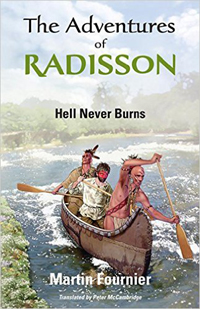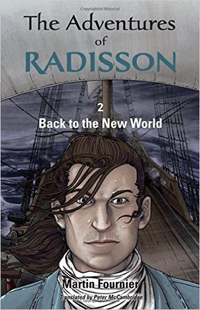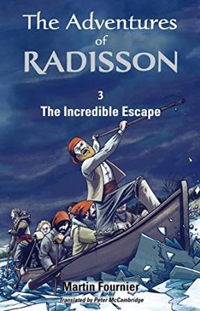| ________________
CM . . .
. Volume XXII Number 36. . . .May 20, 2016

 |
Hell Never Burns. (The Adventures of Radisson 1).
Martin Fournier. Translated by Peter McCambridge.
Montreal, PQ: Baraka Books, 2012.
228 pp., trade pbk., $19.95.
ISBN 978-1-926824-54-3.
Grades 7-10 / Ages 10-15.
Review by Ruth Latta.
***½ /4
|
| |
|
 |
Back to the New World. (The Adventures of Radisson 2).
Martin Fournier. Translated by Peter McCambridge.
Montreal, PQ: Baraka Books, 2013.
194 pp., trade pbk., epub, pdf & mobi, $16.95 (pbk.), $12.99 (epub), $12.99 (pdf).
ISBN 978-1-77186-026-0 (pbk.), ISBN 978-1-77186-027-7 (epub), ISBN 978-1-77186-028-4 (pdf), ISBN 978-1-77186-029-1 (mobi).
Grades 7-10 / Ages 10-15.
Review by Ruth Latta.
***½ /4
|
| |
|
 |
The Incredible Escape. (The Adventures of Radisson 3).
Martin Fournier. Translated by Peter McCambridge.
Montreal, PQ: Baraka Books, 2015.
141 pp., trade pbk., epub, pdf & mobi, $16.95 (pbk.), $12.99 (epub), $12.99 (pdf).
ISBN 978-1-77186-025-3 (pbk.), ISBN 978-1-77186-061-1 (epub), ISBN 978-1-77186-062-8 (pdf), ISBN 978-1-77186-063-5 (mobi).
Grades 7-10 / Ages 10-15.
Review by Ruth Latta.
***½ /4
|
| |
|

excerpt:
As in a dream, Orinha (Radisson) imagined himself coming to this part of the world in different circumstances, to put into action an idea that had always been dear to him... He could see himself returning here to trade. Orinha floated across the immense lake, across time, in a parallel world where humans, spirits, animals, earth and water lived together in harmony. (From Hell Never Burns.)
The cross...is our only weapon. Our intention is to convert them, not to go to war with them." (From Back to the New World)
Radisson looked down at the eagle-headed knife lying on the ground in front of him... [He] could see more clearly now: his destiny would not stop here, nor in New France. He would have to go far out west to where the knife had been made, to where the knife was pulling him. It was showing him a direction to follow. His life was one of travel, discovery and peace. His flight would have to take him further. When he closed his eyes, Radisson felt as though he were slowly taking off, like an eagle spreading its wings." (From The Incredible Escape.)
In an afterword in The Incredible Escape, the third volume of “The Adventures of Radisson” series, author Martin Fournier describes himself as a "historian turned novelist". Fascinated by Pierre-Esprit Radisson (1636-1710), Fournier read the six accounts of Radisson’s travels and spent five years studying his background. Having written his Master's and Ph.D. theses on the famous fur trader/explorer who was influential in the founding of the Hudson's Bay Company, Fournier is recognized as a specialist on this historic figure whom he has brought to life in his three young adult novels.
Radisson and his brother-in-law, Groseilliers, went on fur-trading expeditions into the North American interior as far as present-day Wisconsin and the upper Mississippi Valley. Later, employed by the English, the pair made several journeys, including one to Hudson Strait and another to Lake Superior, where they found copper deposits. Radisson also founded Moose Factory on James Bay. The brothers-in-law switched allegiance between England and France several times. Radisson eventually retired to England on a Hudson's Bay Company pension.
In the first volume, Hell Never Burns, which begins in 1651, readers see Pierre Radisson, a fatherless, adventurous 15-year-old, arriving from Paris and going to his sister’s home at Trois-Rivieres, New France. He goes hunting Canada geese with two companions his own age and is captured by the Iroquois. Lucky to be alive (his companions are killed), Radisson realizes that his life depends on his "ability to transform himself" into a true native. He comes to love the couple who adopt him, takes the name "Orinha", learns practical skills and forces himself to think like an Iroquois when fighting a bloody battle against the Erie people.
The author skilfully blends action with information about the Eastern woodland natives' way of life, including their political arrangements. The Iroquois League (or Confederacy) was an alliance of the Mohawk, Onondaga, Cayuga and Seneca nations. The Iroquois trade with the Dutch settlements in present-day New York state, and Radisson is eager to go along. In the Dutch colony, someone sees that Radisson is not native, and the Dutch governor offers to buy his freedom from "the clutches of these barbarians". Radisson, in the grip of Stockholm Syndrome, declines, but when an Iroquois faction turns against him, he flees to the Dutch for refuge. Hell Never Burns ends with Radisson, now 17, setting out for Amsterdam in the company of another refugee, a Jesuit priest.
In the next book, Back to the New World, Fournier was faithful to Radisson's account, but Fournier had to apply more imagination to the story as Radisson didn't write about his time back in France or his return to New France. Drawing on his knowledge of France in the mid-1600s, Fournier shows readers French people in various walks of life, from bakers to bargemen. The war between the rebel princes and the royalists has devastated the area around Paris. Soldiers have ravaged the crops, gangs threaten travellers, and villages lie in ruins.
Back to the New World shows that Europeans are as bellicose and violent as the Iroquois were in Hell Never Burns. Readers who read the books in sequence, however, will not see examples of European violence in the first novel, and so their first impression will be that the native people are very bloodthirsty. The battle scenes and depictions of torture in Back to the New World are vividly presented. It is hard to strike a balance between accuracy and realism on the one hand and, on the other, concern for the sensibilities of youth. Because of the gory sections, I recommend the second book for readers over twelve.
From old France, Radisson returns to the new world as an employee of the Jesuits, to assist their missionaries in their travels to win souls. Fatherless, Radisson now finds himself with many Jesuit "fathers", and he also has flashbacks to his kindly Iroquois father. Trois Rivieres militia captain, Pierre Godefroy, who has lost a son Radisson's age, informally adopts him.
In the third volume, readers see Radisson emerge as a wise leader and clever strategist who needs no paternal guidance. The Incredible Escape shows Radisson uncovering an Iroquois plot to wipe out the Jesuit settlement and forming a successful plan to get the 50 Frenchmen back safely to New France before the Iroquois act. Godefroy, who confided to Radisson his doubts about the wisdom of the Jesuits' hinterland venture and the endurance of the peace, is proven right. Fournier presents both the Iroquois and the French points of view fairly. Radisson realizes that, while the Iroquois are happy to trade, they find the French fortification intrusive, fear European illnesses, and dislike Jesuit proselytizing.
The characters are well-drawn. The seeming inconsistencies in Radisson's personality make him human. In the opening book, Radisson’s changing feelings during his captivity are understandable and easy to identify with. In the second volume, Radisson’s muted grief for his missing mother suggests that, during that time period, one had to recover quickly from loss in order to survive. In the third book, alone in a canoe with hostile Iroquois, Radisson falls prey to the irrational fear that the natives have taken his eagle knife to drain the weapon of its power and cast a spell on him. Later, though, when uncovering an Iroquois plan to massacre the 50 Frenchmen and organizing their successful escape, he is realistic and shrewd. His traits foreshadow his shifting allegiances later in life.
Once safely back in New France, Radisson meets his new brother-in-law, Medard Chouart. Mentioned earlier as someone who disappeared and was presumed dead, Chouart surprised his community by returning, after two years' absence, from a journey to the Great Lakes. Securing many furs and trading connections, he was honoured by the governor with the title "Des Groseilliers". The conclusion, with the two brothers-in-law teaming-up for trading ventures, points to more adventures to come.
Highly Recommended.
An author, Ruth Latta lives in Ottawa, ON. For more information about Ruth's writing, visit http://ruthlattabooks.blogspot.com

To comment
on this title or this review, send mail to cm@umanitoba.ca.
Copyright © the Manitoba Library Association. Reproduction for personal
use is permitted only if this copyright notice is maintained. Any
other reproduction is prohibited without permission.
Next Review | Table of Contents For This Issue - May 20, 2016
CM Home | Back Issues
| Search
| CM Archive
| Profiles Archive
|


